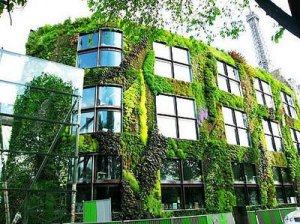The Urban Farmer, Issue #022
March,
2010: 5 Quick Hydro Tips * Are Hydroponic Crops
Nutritious? *
Goodies on tap

~These amazing living walls are designed by Patrick Blanc. Patrick Blanc is a
French landscape designer and botanist who patented the vertical hydroponic
garden he calls “le mur végétal”. Here is an example of the stunning living wall
art at Stella McCartney’s store.
5 QUICK TIPS FOR A GREAT HYDROPONIC
GARDEN
Number 1: Get Your Plants Off to a Good Start
For best results, choose disease resistant varieties of seed and sprout your own
baby plants! Seeds can be germinated in individual sprouter “plugs”, which
consist of hydroponics-friendly medium. In your plant nursery, keep it warm,
moist (but not saturated), and most importantly… very bright light; like
flurorescents, hung very close to the seedling tops. This helps produce short,
thick stocky baby plants. (All
about seedlings)
Number 2: The Right Light
Different plants have different light requirements – and a single plant has
different light needs at different stages. Lettuces, cooking herbs and leafy
greens will do fine with T5 fluorescents. Flowering or fruiting crops need HID
lighting, two different kinds at different stages of growth. A plant in the
early leafy growth stage needs more blue spectrum light, or Metal halide (MH);
whereas when it reaches the flowering or fruiting stage, it uses more of the red
spectrum, or High Pressure Sodium (HPS). (All
about lighting)
Number 3: Proper Nutrition
All plants require some sixteen different mineral nutrients in order to reach
their full potential. These fall into the category of either micronutrients or
micronutrients. Do not use Hyponex plant food or other liquid houseplant foods.
Only nutrients specially formulated for hydroponics will keep your hydro garden
healthy and productive. (All
about plant nutrients)
Number 4: Preventing Disease and Warding Off Pests
Just as with traditional gardening, hydroponics means battling unwanted insects
and plant diseases. The best ways to avoid these problems consist of maintaining
a clean growing environment, selecting hearty, disease-resistant plants,
ventilation and temperature control, and constant monitoring for problems. The
latter is especially important; most problems are easily cured if caught in
their initial stages. (Pests
& Plagues)
Number 5: Keeping it Pruned
Discolored, insect-eaten or unhealthy leaves and diseased roots should be
removed with a pair of sharp scissors. Judicious pruning will also help your
plants to grow fuller and allow it to concentrate its energy on more productive
shoots. Dip the shears in rubbing alcohol to kill any bad bugs which might be
hanging out there.
ARE HYDROPONIC CROPS NUTRITIOUS?
(Some excerpts by Andrew Weil, Universal Press
Syndicate, Tucson, Arizona)
Q: I’m thinking about a hydroponic garden. Can you tell me whether the
veggies and herbs grown in hydroponic gardens are as nutritious as those grown
in the soil?
A: In a traditional garden, plants get many of their nutrients from the
soil. In a hydroponic garden, the nutrients must be supplied via specially
formulated mixes.
The question of whether plants grown in hydroponic gardens are as nutritious as
those grown in soil has never been answered. Some experts believe that the
growing method has little to do with a plant’s nutritional value. And some
maintain that the fact that plants don’t come into contact with the soil makes
them healthier because there’s less of a chance that they’ll pick up diseases.
On the other hand, the pathogens in the complex soil environment can make some
plants produce higher amounts of beneficial compounds.
I haven’t been able to find studies that settle the issue one way or the other,
but I did come across a 1994 industry-commissioned study that concluded that
hydroponic peppers and tomatoes were more nutritious — and more flavorful — than
the same varieties grown organically and grown by conventional methods.
A big question relating to hydroponics is whether vegetables grown this way can
be considered “organic”. Some commercial hydroponic growers use pesticides on
their crops, and while home hydroponic gardeners can get organic media in which
to grow their plants, most commercial operations rely on solutions of chemicals
and minerals that don’t qualify as “organic”.
[Note from ed: the hydroponic gardens we grow and describe in our website are
not “organic” in the true sense of the word. You can try to grow an organic
hydro garden by buying “organic” nutrient solutions. However, we do not
recommend this, as these organic mixes rely on composting, or formation of an
organic food cycle within your system. This can be quite tricky to manage. We
have never done a true organic garden, and urge you to save this method for
after you have gone the pure chemical nutrient route, and have some experience
under your belt].
GOODIES ON TAP:
UPDATE!
We are hard at work on our new kits and ebook offerings. Soon we
will be launching the following:
- Make a PVC hydroponics stand (2 kits)
- Build a sturdy, turbo-cooled grow closet (ebook/kit)
- Ebook: Plans for all 4 full-sized hydro
gardens in one book! (ebb & flow, top drip, raft and wick), PLUS the PVC
stand, with many great
bonuses.
We are very excited about these new products
and apologize for the “coming soon” signs you may have seen around the site
(don’t you hate that?). We hope to have these new pages up and running in a
couple of months… hopefully right after Easter… just in time for your spring garden!
Hydro Tip of the Month
For your hydroponic garden, you will find that you only need a few of the seeds
from each seed packet. Did you know that you can easily save the leftover seed
for 3-4 years and not lose viability (ability to sprout)?
Here’s how: Keep them in the original packet, fold over and over to
close packet tightly. Place all the packets in a clean, dry mayo jar, (or triple
bag them in ziploc bags). Place some silica gel (like you find in beef jerky) or
pour a tablespoon of dry powdered milk in a tissue and fold it up, this does the
same thing. Close the jar tightly and store in the refrigerator (not freezer).
Easy and economical!
We hope you have enjoyed this issue of The Urban Farmer Ezine. Each month, we will bring you another inspiring photo, gardening quote or idea, plus fresh new hydroponics news, techniques & products.
Insiders tips to get you growing…

~Stella and Simon from
Hydroponics-Simplified.
|


Reply